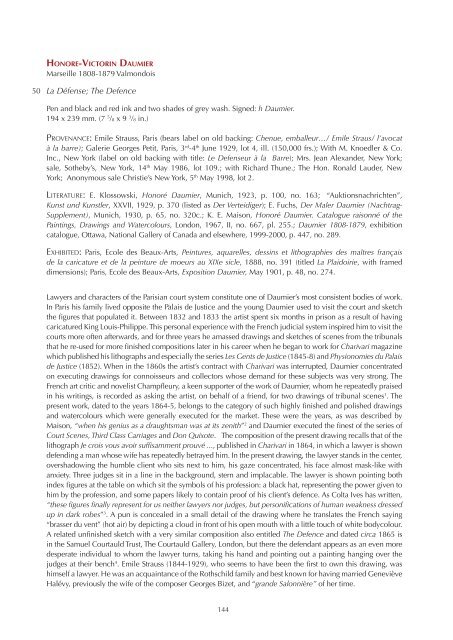Catalogue-2014-Jean-Luc-Baroni
- No tags were found...
You also want an ePaper? Increase the reach of your titles
YUMPU automatically turns print PDFs into web optimized ePapers that Google loves.
Honore-Victorin Daumier<br />
Marseille 1808-1879 Valmondois <br />
50<br />
La Défense; The Defence<br />
Pen and black and red ink and two shades of grey wash. Signed: h Daumier.<br />
194 x 239 mm. (7 5 /8 x 9 3 /8 in.)<br />
Provenance: Emile Strauss, Paris (bears label on old backing: Chenue, emballeur…/ Emile Straus/ l’avocat<br />
à la barre); Galerie Georges Petit, Paris, 3 rd -4 th June 1929, lot 4, ill. (150,000 frs.); With M. Knoedler & Co.<br />
Inc., New York (label on old backing with title: Le Defenseur à la Barre); Mrs. <strong>Jean</strong> Alexander, New York;<br />
sale, Sotheby’s, New York, 14 th May 1986, lot 109.; with Richard Thune.; The Hon. Ronald Lauder, New<br />
York; Anonymous sale Christie’s New York, 5 th May 1998, lot 2.<br />
Literature: E. Klossowski, Honoré Daumier, Munich, 1923, p. 100, no. 163; “Auktionsnachrichten”,<br />
Kunst und Kunstler, XXVII, 1929, p. 370 (listed as Der Verteidiger); E. Fuchs, Der Maler Daumier (Nachtrag-<br />
Supplement), Munich, 1930, p. 65, no. 320c.; K. E. Maison, Honoré Daumier. <strong>Catalogue</strong> raisonné of the<br />
Paintings, Drawings and Watercolours, London, 1967, II, no. 667, pl. 255.; Daumier 1808-1879, exhibition<br />
catalogue, Ottawa, National Gallery of Canada and elsewhere, 1999-2000, p. 447, no. 289.<br />
Exhibited: Paris, Ecole des Beaux-Arts, Peintures, aquarelles, dessins et lithographies des maîtres français<br />
de la caricature et de la peinture de moeurs au XIXe sicle, 1888, no. 391 (titled La Plaidoirie, with framed<br />
dimensions); Paris, Ecole des Beaux-Arts, Exposition Daumier, May 1901, p. 48, no. 274.<br />
Lawyers and characters of the Parisian court system constitute one of Daumier’s most consistent bodies of work.<br />
In Paris his family lived opposite the Palais de Justice and the young Daumier used to visit the court and sketch<br />
the figures that populated it. Between 1832 and 1833 the artist spent six months in prison as a result of having<br />
caricatured King Louis-Philippe. This personal experience with the French judicial system inspired him to visit the<br />
courts more often afterwards, and for three years he amassed drawings and sketches of scenes from the tribunals<br />
that he re-used for more finished compositions later in his career when he began to work for Charivari magazine<br />
which published his lithographs and especially the series Les Gents de Justice (1845-8) and Physionomies du Palais<br />
de Justice (1852). When in the 1860s the artist’s contract with Charivari was interrupted, Daumier concentrated<br />
on executing drawings for connoisseurs and collectors whose demand for these subjects was very strong. The<br />
French art critic and novelist Champfleury, a keen supporter of the work of Daumier, whom he repeatedly praised<br />
in his writings, is recorded as asking the artist, on behalf of a friend, for two drawings of tribunal scenes 1 . The<br />
present work, dated to the years 1864-5, belongs to the category of such highly finished and polished drawings<br />
and watercolours which were generally executed for the market. These were the years, as was described by<br />
Maison, “when his genius as a draughtsman was at its zenith” 2 and Daumier executed the finest of the series of<br />
Court Scenes, Third Class Carriages and Don Quixote. The composition of the present drawing recalls that of the<br />
lithograph Je crois vous avoir suffisamment prouvé ..., published in Charivari in 1864, in which a lawyer is shown<br />
defending a man whose wife has repeatedly betrayed him. In the present drawing, the lawyer stands in the center,<br />
overshadowing the humble client who sits next to him, his gaze concentrated, his face almost mask-like with<br />
anxiety. Three judges sit in a line in the background, stern and implacable. The lawyer is shown pointing both<br />
index figures at the table on which sit the symbols of his profession: a black hat, representing the power given to<br />
him by the profession, and some papers likely to contain proof of his client’s defence. As Colta Ives has written,<br />
“these figures finally represent for us neither lawyers nor judges, but personifications of human weakness dressed<br />
up in dark robes” 3 . A pun is concealed in a small detail of the drawing where he translates the French saying<br />
“brasser du vent” (hot air) by depicting a cloud in front of his open mouth with a little touch of white bodycolour.<br />
A related unfinished sketch with a very similar composition also entitled The Defence and dated circa 1865 is<br />
in the Samuel Courtauld Trust, The Courtauld Gallery, London, but there the defendant appears as an even more<br />
desperate individual to whom the lawyer turns, taking his hand and pointing out a painting hanging over the<br />
judges at their bench 4 . Emile Strauss (1844-1929), who seems to have been the first to own this drawing, was<br />
himself a lawyer. He was an acquaintance of the Rothschild family and best known for having married Geneviève<br />
Halévy, previously the wife of the composer Georges Bizet, and “grande Salonnière” of her time.<br />
144
















